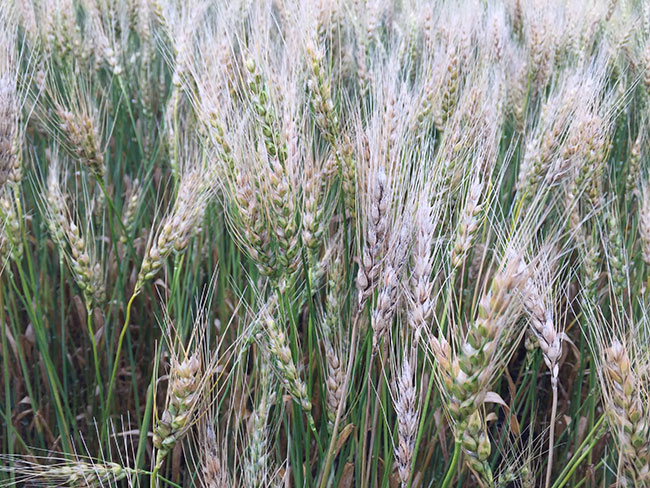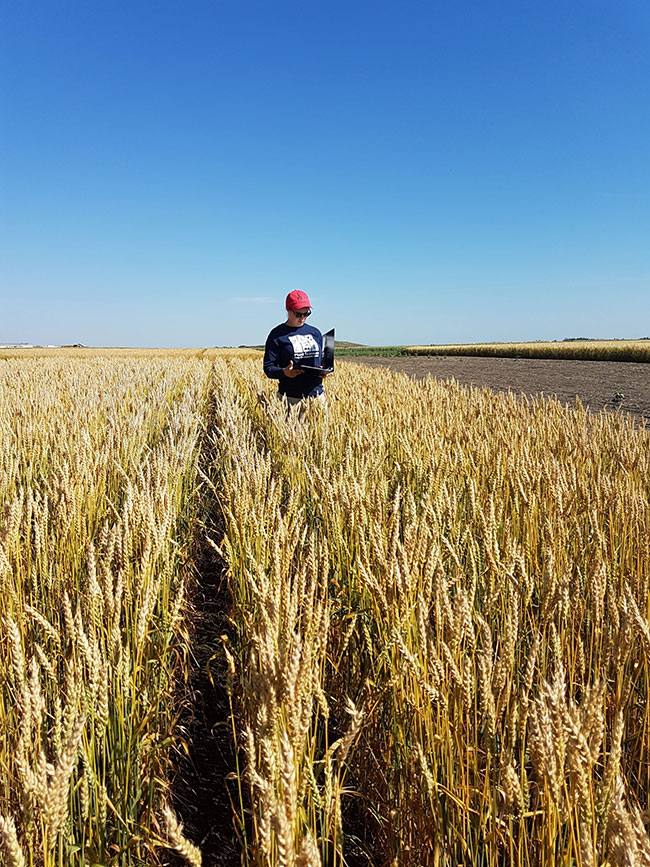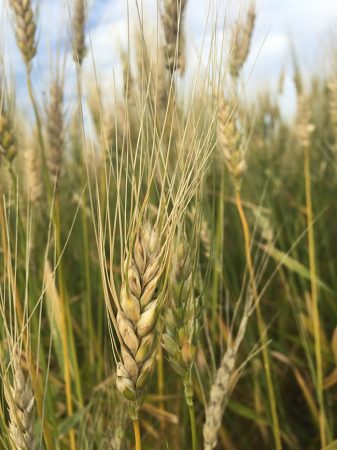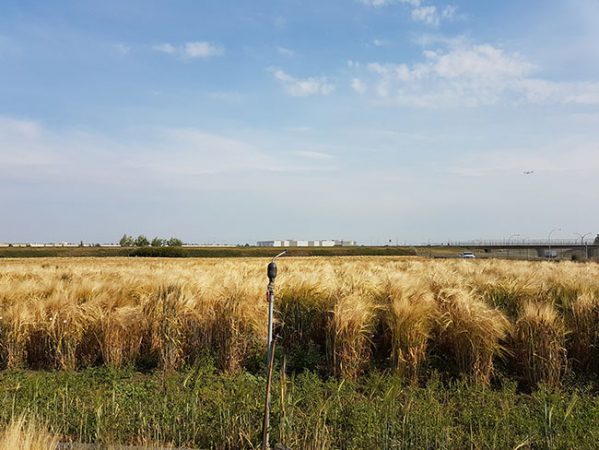
Features
Diseases
New sources of resistance for FHB in spring wheat
Researchers identify high priority FHB resistance genes with potential for improving Canadian wheat germplasm.
April 7, 2019 By Donna Fleury
 FHB disease in wheat in untreated field disease nursery plot in Saskatoon. Photo courtesy of G. Brar, University of Saskatchewan.
FHB disease in wheat in untreated field disease nursery plot in Saskatoon. Photo courtesy of G. Brar, University of Saskatchewan. Fusarium head blight (FHB) is a serious disease in wheat across Western Canada, causing substantial losses in some crops. This disease can significantly reduce yields and also result in downgrading or complete loss due to high toxin content in the grain. FHB creates a management challenge because highly resistant wheat varieties are not available and fungicides do not provide complete FHB control. Therefore, researchers and plant breeders continue to investigate new forms of FHB resistance.
Randy Kutcher, professor and chair of the Cereal and Flax Crop Pathology Lab at the University of Saskatchewan, in collaboration with Plant Gene Resources of Canada (PGRC) and the National Research Council (NRC), is investigating new sources of FHB resistance in spring wheat. “We recognize that host resistance, coupled with other integrated pest management practices, is considered the best approach to control FHB,” Kutcher explains. “FHB is a difficult disease against which to develop resistance in wheat, as breeders have to bring in several resistance genes together because there isn’t a single gene offering strong resistance to FHB. Therefore, the objectives of our recent project launched in 2016 are to identify wheat germplasm with new sources of FHB resistance by screening PGRC accessions and evaluate them in our field FHB nursery. A second objective is to identify novel alleles for FHB resistance from a synthetic hexaploid wheat population.”

Mallory Dyck, technical officer at U of S, rating FHB disease in the field research trials. Photo courtesy of L. Wang.
The project began with an evaluation of 14,000 wheat accessions from the PGRC collected from all over the world. Researchers selected 4,000 lines for further screening. “We then evaluated these 4,000 PGRC lines, along with an additional 412 lines from a synthetic hexaploid wheat association mapping (SHW AM) panel in our FHB disease nursery at Saskatoon in 2016 and 2017,” says Lipu Wang, research officer at the University of Saskatchewan. “The FHB disease incidence and severity was assessed for each line to determine the FHB index. As a result, 400 lines with the lowest FHB index were selected for further genome-wide association study (GWAS) analysis.”
The GWAS analysis was applied to identify novel resistance alleles or markers associated with resistance from these 400 lines. “From the GWAS analysis in 2016 and 2017, we were able to identify seven high priority genes or QTLs that we can potentially utilize to introduce FHB resistance into our Canadian germplasm,” explains Wentao Zhang, assistant research officer with the NRC in Saskatoon. “We are continuing to conduct more high-resolution analysis on these 400 lines to identify additional interesting resistant QTLs.”

FHB infected wheat head in disease nursery plots, Saskatoon. Photo by G. Singh, University of Saskatchewan.
Zhang adds resistance breeding currently relies heavily on resistance from Asian sources and therefore the goal is to try to identify novel sources from other regions that may offer different resistance. Although resistance can be successfully moved from other sources to Canadian cultivars, the result can be lower yield and quality. “Therefore, we are trying to identify novel sources from bread wheat, amber wheat and tetraploid wheat that can provide improved Canadian cultivars and balance higher disease resistance with yield, quality and other agronomic traits. Many of the bread wheat varieties currently available have moderate resistance to FHB, but we would like to be able to increase that to high FHB resistance. Durum wheat is still a big challenge for breeders, with efforts underway to move varieties from susceptible to at least an intermediate level of resistance.”
Researchers are continuing to further investigate the genetic structure of these new resistance sources and rescreening the levels of resistance of the most promising lines. Once the project is complete, the most promising lines and useful new sources of FHB resistance will be made available to wheat breeders. Eventually, these new resistances will be introgressed into elite Canadian spring wheat.
“We have recently started a new related project, and are taking the most promising lines and rescreening them for mycotoxins, such as deoxynivalenol (DON),” Wang says. “The ultimate goal in FHB resistance breeding is to develop productive cultivars with disease resistance and low mycotoxin contamination despite high infection pressure. In this project, we are working on identifying markers and developing a rapid, accurate and low cost DON diagnostic and quantification platform for high-throughput DON phenotyping. We are also developing tools to simultaneously identify and quantify DON and its derivatives, including D3G (deoxynivalenol-3- glucosides) and others. This approach will allow breeders and industry to screen and analyze a large number of samples faster, cheaper and more reliably for toxins in wheat infected by FHB. This project together with the development of new sources of FHB resistance will help researchers and plant breeders to improve FHB resistance in Canadian wheat cultivars in the future.”
